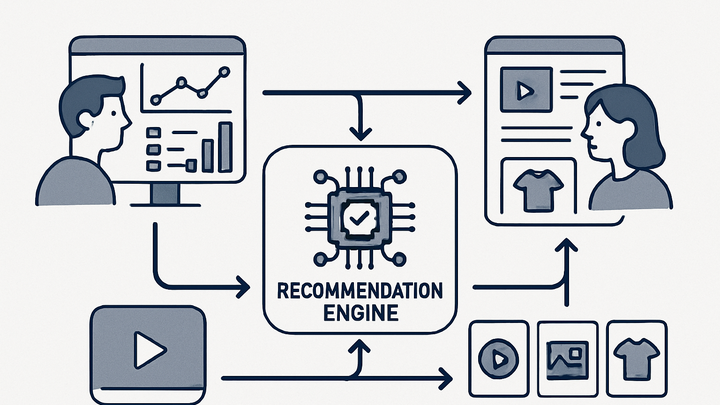Published on 2025-06-22T09:14:25Z
What is a Recommendation Engine? Analytics Industry Examples
Recommendation Engine is a class of machine learning systems that analyze user behavior, item attributes, and contextual data to deliver personalized suggestions. In the analytics industry, recommendation engines leverage event streams from platforms like PlainSignal and GA4 to understand what content or products users find most engaging. Historical interaction data—page views, clicks, purchase history—is ingested and processed via methods such as collaborative filtering, content-based filtering, or hybrid approaches. The pre-filtered data sets can be exported to environments like BigQuery or custom data warehouses for model training using Python, R, or cloud-based AutoML services. Once trained, these models run in real time to generate predictions and update recommendations as users interact with the application. Deployment involves integrating recommendation APIs into your frontend or backend, ensuring low latency and high availability. Proper attention to the cold-start problem, data sparsity, and privacy compliance ensures a robust and user-centric recommendation system.
Recommendation engine
A system that uses analytics data and machine learning to suggest personalized content or products to users.
Core Methodologies
Overview of the main algorithmic approaches used in recommendation engines, explaining their focus and trade-offs.
-
Collaborative filtering
Relies on user-item interaction patterns to recommend items based on similar users or similar items. Effective when you have rich interaction data.
-
Content-based filtering
Analyzes item attributes (such as tags, categories, or descriptions) and user profiles to recommend items similar to those a user has engaged with before.
-
Hybrid approaches
Combines collaborative and content-based methods to mitigate the limitations of each and improve recommendation accuracy and diversity.
Benefits and Challenges
Key advantages of recommendation engines along with common implementation challenges.
-
Benefits
Personalization, increased engagement, higher conversion rates, and improved user retention.
-
Personalization
Tailors experiences based on individual user behavior and preferences, boosting satisfaction.
-
Increased engagement
Relevant suggestions encourage users to explore more content or products.
-
Revenue growth
Targeted upsells and cross-sells drive higher average order values and repeat purchases.
-
-
Challenges
Common obstacles such as the cold-start problem, data sparsity, privacy concerns, and computational complexity.
-
Cold-start problem
New users or items lack historical data, making initial recommendations less accurate.
-
Data privacy
Balancing personalization with user privacy and compliance regulations like GDPR.
-
Scalability
Processing and serving recommendations in real time at scale can be resource-intensive.
-
Building with Analytics Platforms
Implementing recommendation engines using data from analytics SaaS products to feed machine learning workflows.
-
Using PlainSignal
PlainSignal offers cookie-free analytics to collect user interactions for recommendation modeling. Add the following snippet to your website to start tracking:
-
Tracking code
<link rel="preconnect" href="//eu.plainsignal.com/" crossorigin /> <script defer data-do="yourwebsitedomain.com" data-id="0GQV1xmtzQQ" data-api="//eu.plainsignal.com" src="//cdn.plainsignal.com/plainsignal-min.js"></script>
-
-
Integrating with GA4
Use Google Analytics 4 to capture custom events and export data for advanced modeling.
-
Event tracking
Define and implement events like
view_item,add_to_cart, and custom engagement metrics in GA4. -
Data export
Export GA4 data to BigQuery for model training with Python, R, or cloud-based ML services.
-
Model deployment
Serve trained recommendation models via APIs or integrate with client-side code for real-time suggestions.
-
